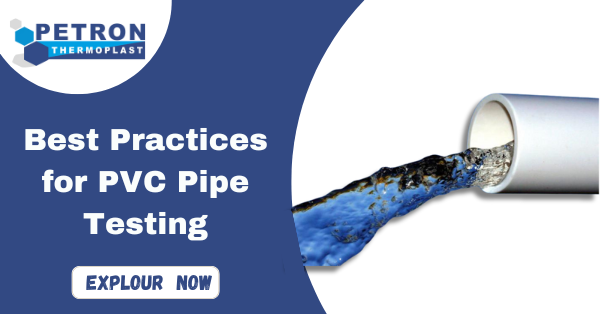Introduction
When it comes to ensuring the longevity and reliability of PVC (Polyvinyl Chloride) pipes, PVC pipe testing methods play a pivotal role. The selection of an appropriate testing method is crucial for identifying potential weaknesses, defects, or irregularities in PVC pipes, ultimately contributing to the overall integrity of a plumbing or industrial system. In this comprehensive guide, we will delve into the intricacies of various PVC pipe testing methods, shedding light on their applications, advantages, and considerations for choosing the right method for your specific needs.
Understanding PVC Pipe Testing
1. Visual Inspection
One of the fundamental PVC pipe testing methods is visual inspection. This involves a meticulous examination of the surface, looking for visible cracks, discoloration, or irregularities. Visual inspection serves as a preliminary assessment and is often the first step in identifying potential issues.
2. Ultrasonic Testing
Ultrasonic testing employs high-frequency sound waves to detect internal defects in PVC pipes. This non-destructive method is particularly effective for identifying issues such as voids, delamination, or thickness variations within the material.
3. Hydrostatic Testing
Hydrostatic testing involves pressurizing the PVC pipe with water to assess its strength and integrity. By subjecting the pipe to pressures higher than its normal operating conditions, any weaknesses or potential leaks can be identified. This method is widely used for quality control in PVC pipe manufacturing.
4. X-ray Inspection
X-ray inspection is a sophisticated method that utilizes X-rays to reveal internal structures and defects in PVC pipes. This is especially useful for detecting hidden issues that may not be visible through traditional visual inspection methods.
5. Acoustic Emission Testing
Acoustic emission testing involves monitoring the acoustic signals emitted by a PVC pipe under stress. This method is sensitive to the release of energy caused by crack propagation or other structural changes, making it an effective tool for detecting incipient failures.
Factors Influencing Method Selection
Choosing the right PVC pipe testing method requires careful consideration of several factors. Here are key elements to keep in mind:
1. Pipe Material and Size
Different PVC pipes may require different testing methods based on their material composition and size. For instance, large-diameter pipes may be better suited for hydrostatic testing, while smaller pipes may benefit more from ultrasonic testing.
2. Project Requirements
Consider the specific requirements of your project. The intended application, environmental conditions, and regulatory standards can all influence the choice of a testing method. Ensure that the selected method aligns with the project’s unique needs.
3. Sensitivity and Accuracy
Each testing method has varying levels of sensitivity and accuracy. Evaluate the criticality of the application and choose a method that provides the necessary precision for identifying potential issues. X-ray inspection and acoustic emission testing are known for their high sensitivity.
4. Non-Destructive vs. Destructive Testing
Determine whether non-destructive or destructive testing is more suitable for your situation. Non-destructive methods, such as ultrasonic testing and X-ray inspection, allow for assessment without causing harm to the PVC pipe, while destructive methods, like cutting and physically inspecting a section, may be necessary in certain cases.
5. Cost Considerations
Budget constraints are an inevitable aspect of any project. Evaluate the costs associated with each testing method, including equipment, labor, and downtime. Striking a balance between effectiveness and cost efficiency is crucial.

Case Studies
To better understand the practical application of PVC pipe testing methods, let’s explore a couple of case studies:
Case Study 1: Industrial Piping System
In an industrial setting where PVC pipes are integral to the conveyance of corrosive fluids, ultrasonic testing proved to be invaluable. This non-intrusive method allowed for the detection of thickness variations in the pipes, preventing potential leaks and ensuring the longevity of the piping system.
Case Study 2: Construction Project
For a large-scale construction project involving the installation of PVC pipes for a water supply network, hydrostatic testing emerged as the preferred method. This comprehensive testing approach identified weak points and potential leaks, ensuring the durability of the installed PVC pipes under varying water pressures.
Emerging Technologies in PVC Pipe Testing
As technology continues to advance, new and innovative PVC pipe testing methods are being developed to address evolving challenges. These methods not only enhance the accuracy of inspections but also provide valuable insights into the structural health of PVC pipes. Here are some emerging technologies in the realm of PVC pipe testing:
1. Infrared Thermography
Infrared thermography is gaining popularity for its ability to detect temperature variations on the surface of PVC pipes. Variations in temperature can be indicative of underlying issues, such as blockages or structural irregularities. This non-contact method provides a quick and efficient means of identifying potential problems.
2. Guided Wave Ultrasonics
While traditional ultrasonic testing is effective, guided wave ultrasonics takes it a step further by allowing the inspection of long sections of PVC pipes without the need for access to both ends. This method is particularly useful for pipelines that are challenging to access or buried underground.
3. Magnetic Flux Leakage
Magnetic flux leakage testing involves using magnetic fields to detect anomalies in the wall thickness of PVC pipes. As the magnetic field interacts with the pipe’s material, any variations in thickness can be identified. This method is especially useful for detecting corrosion and erosion.
4. Digital Radiography
Advancements in digital radiography have introduced more efficient and high-resolution imaging for X-ray inspection. Digital radiography not only reduces exposure times but also provides clearer images, enabling a more detailed analysis of PVC pipe structures.
Best Practices for PVC Pipe Testing

To ensure the effectiveness of PVC pipe testing methods, it’s essential to adhere to best practices throughout the testing process. Here are some recommendations:
1. Establish a Testing Schedule
Regular and systematic testing is crucial for identifying potential issues before they escalate. Establish a testing schedule based on the specific requirements of your project or industry standards.
2. Train Personnel
Properly trained personnel are essential for accurate and reliable testing. Ensure that individuals involved in the testing process are trained in the selected testing methods and are familiar with the equipment used.
3. Recordkeeping and Documentation
Maintain comprehensive records of all testing activities. Documenting the results, including any anomalies detected and actions taken, provides valuable insights for future assessments and contributes to a proactive maintenance strategy.
4. Combine Multiple Methods
In many cases, a combination of PVC pipe testing methods may provide a more thorough assessment. Combining methods such as visual inspection, ultrasonic testing, and hydrostatic testing can offer a comprehensive understanding of a PVC pipe’s condition.
5. Stay Informed About Industry Advances
Given the rapid evolution of technology, staying informed about the latest advancements in PVC pipe testing is crucial. Attend industry conferences, participate in training programs, and engage with experts to stay abreast of emerging trends and technologies.
Conclusion
The landscape of PVC pipe testing methods continues to evolve, offering a diverse range of options for ensuring the structural integrity of PVC pipes. Whether leveraging traditional methods like hydrostatic testing or exploring cutting-edge technologies such as magnetic flux leakage, the key is to tailor the testing approach to the specific requirements of the project.
As industries increasingly rely on PVC pipes for various applications, the importance of robust testing methodologies cannot be overstated. Implementing a well-rounded testing strategy, incorporating both established and emerging methods, contributes not only to the longevity of PVC pipes but also to the overall safety and efficiency of plumbing and industrial systems. By staying informed, embracing technological advancements, and adhering to best practices, stakeholders can confidently navigate the complexities of PVC pipe testing and ensure the continued success of their projects.
Frequently Asked Questions (FAQ) about PVC Pipe Testing Methods
1. What are PVC Pipe Testing Methods?
PVC pipe testing methods are procedures and techniques employed to assess the quality, structural integrity, and performance of Polyvinyl Chloride (PVC) pipes. These methods include visual inspection, ultrasonic testing, hydrostatic testing, X-ray inspection, acoustic emission testing, and emerging technologies like infrared thermography and guided wave ultrasonics.
2. Why is PVC Pipe Testing Important?
PVC pipe testing is crucial for ensuring the reliability and durability of PVC pipes in various applications, including plumbing and industrial systems. Testing helps identify potential defects, weaknesses, or irregularities in pipes, preventing unexpected failures, leaks, and ensuring the overall integrity of the piping system.
3. What is Visual Inspection in PVC Pipe Testing?
Visual inspection involves a meticulous examination of the external surface of PVC pipes to identify visible defects, discoloration, or irregularities. It serves as a preliminary assessment to determine if further, more in-depth testing methods are required.
4. How does Ultrasonic Testing Work for PVC Pipes?
Ultrasonic testing utilizes high-frequency sound waves to detect internal defects in PVC pipes. The waves are transmitted through the material, and variations in the waves’ reflections can identify issues such as voids, delamination, or thickness variations within the PVC pipe.
5. What is Hydrostatic Testing in PVC Pipe Inspection?
Hydrostatic testing involves pressurizing PVC pipes with water to assess their strength and integrity. By subjecting the pipes to pressures higher than normal operating conditions, any weaknesses, leaks, or potential issues can be identified, ensuring the quality of the pipes.
You May Also Like : Chemical Tanks, What is CNC Turning?

